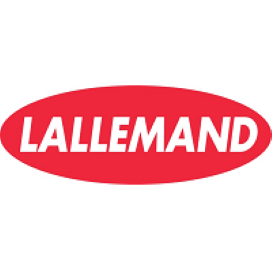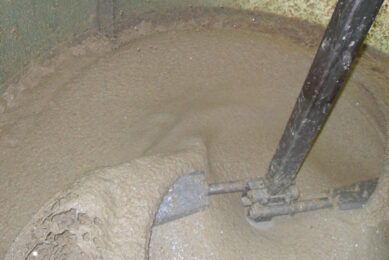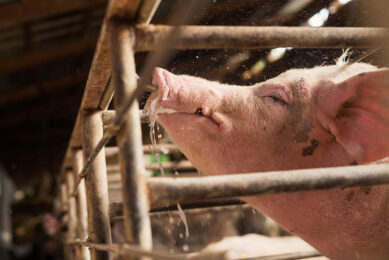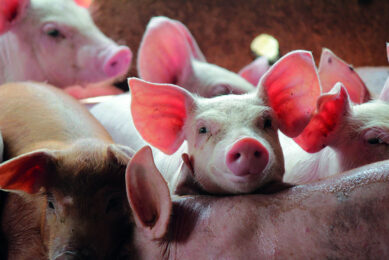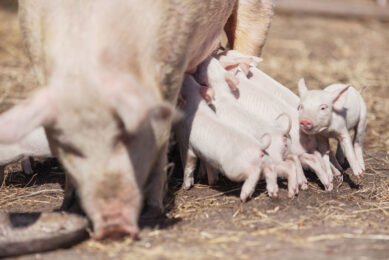An outside-in approach for replacing ZnO in piglets
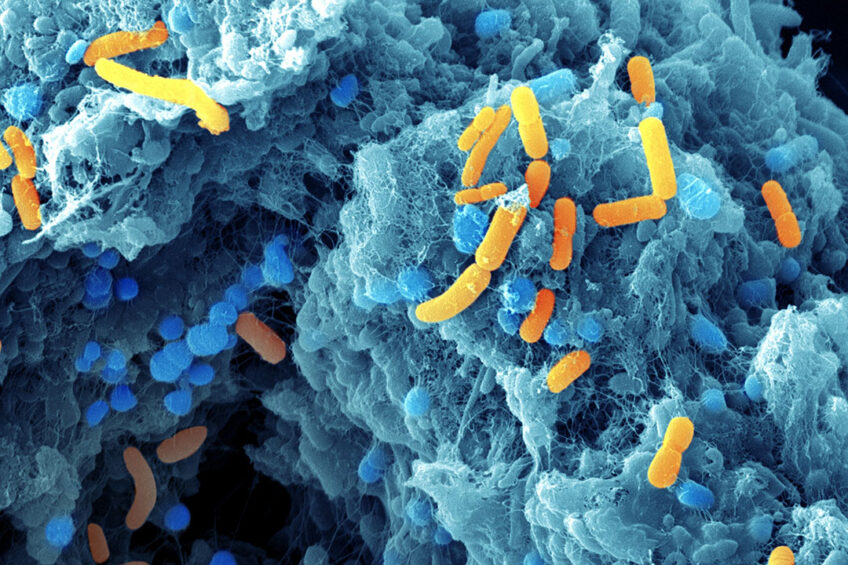
For swine producers all around Europe, 2022 marks the end of medicinal zinc oxide (ZnO) use and the deadline to find alternative strategies for weaning. The best option is probably to take one step back and look at the whole production cycle, from the sow to the piglet, and implement a multifactorial approach to piglet management.
At 3 to 4 weeks of age, when piglets are removed from the sow, they have not yet developed optimal digestive functions. Their digestive capacity and natural defences are still immature. The sudden diet transition and the social and environmental changes they encounter at weaning lead to significant digestive hurdles. Transient loss of appetite and subsequent microbial dysbiosis and gut inflammatory status are common.
Farm management should help piglets cope with these issues and also needs to meet the requirement to reduce antibiotics and ZnO use. Management objectives should consider limiting the exposure to pathogens from the environment, strengthening gut function and optimising nutrient retention.
To address that multifactorial challenge, the latest developments in swine production suggest a holistic approach combining environmental, nutritional, piglet quality and gut health strategies (see Figure 1).
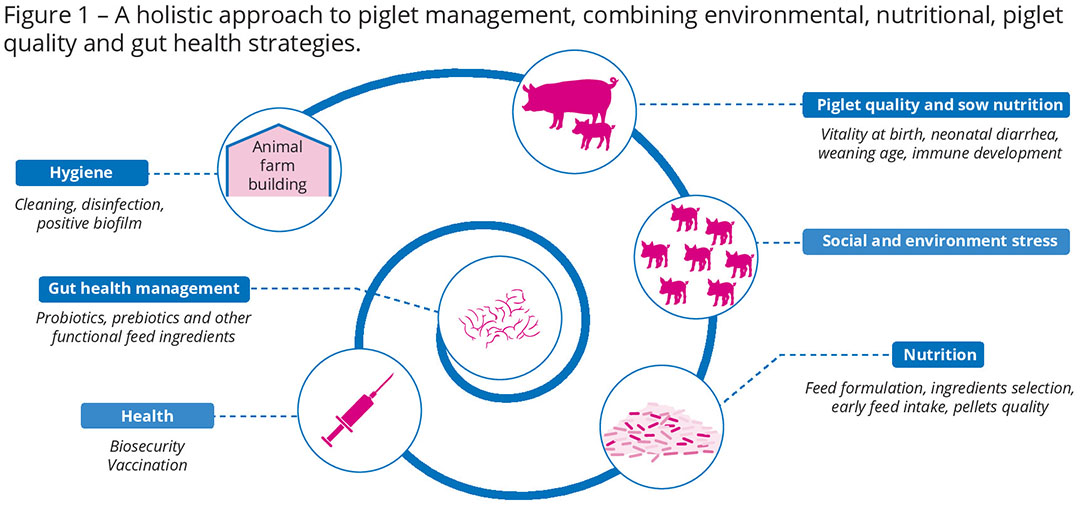
1. Controlling microbial pressure
First, biosecurity measures should be taken to prevent the entrance of pathogens to the farm. That includes paying particular attention to people, vehicles, rodents, birds, domestic animals, routes of transmission, piglet origin, feed and water hygiene.
In addition, piglet health must be secured with a comprehensive life cycle vaccination programme prescribed by the farm’s veterinarian.
Thirdly, it is essential to pay attention to ambient temperatures and feeding space. Those actions help reduce social and environmental stresses.
Other measures should be taken inside the farm to avoid the spread of any disease or potential pathogenic agent. It should include procedures of cleaning and disinfection but also the establishment of a microbial positive biofilm on barn surfaces as an innovative internal biosecurity solution. The positive biofilm solution Lalfilm Pro combines selected bacteria to install a positive biofilm on farm building surfaces.
2. Managing sow gut health
To raise piglets that are well equipped to cope with this challenging transition, parameters such as weaning age and weight can be adjusted. The former can be managed with early attention to sow farrowing conditions in order to improve piglet vitality at birth and thus the colostrum intake.
Modulation of the sow digestive microbiota is one of the drivers to help reduce the incidence of neonatal diarrhoea. At birth and during lactation, maternal microbial imprinting contributes to offspring microbiota establishment and exerts a long-lasting influence on animal health and performance, even after weaning.
Supplementation of gestating and lactating sow diets with the well-documented probiotic yeast Saccharomyces cerevisiae
boulardii CNCM I-1079 (Levucell SB) has been shown to ease the farrowing conditions and modulate the sow’s microbial profile, subsequently influencing piglet microbial profile and performance at weaning.
3. Ensuring early feed intake
Before weaning, it is possible to stimulate solid feed intake and reduce anorexia consequences by offering creep feed to suckling piglets. Feed presentation is important. It is important to pay attention to technological aspects of feed that will optimise feed intake. For example, monitor criteria such as pellet diameter, hardness and particle size.
After weaning, dietary ingredients should be considered with enhanced palatability properties, such as flavours and functional yeast proteins to help stimulate feed intake. For instance, a trial in post-weaning piglets has shown a 17% increased feed intake during the first week post-weaning with addition of a specific hydrolysed yeast in the diet (Yela Prosecure).
4. Offering quality nutrients
When piglets start eating dry feed, nutrients arriving in the immature intestinal environment are not absorbed in an optimal way. Some of those nutrients reach the hindgut and undergo proteolytic fermentation. Feed formulations should target highly digestible nutrients for optimal absorption.
Precision feeding practices should consider fibre profiles (insoluble/soluble NSP), protein levels for balanced and highly digestible sources and mineral compounds that may increase the feed buffering capacity.
Along with benefits to feed palatability, the use of functional yeast proteins with fast kinetic absorption can help limit the risk of proteolytic fermentation in the hindgut. For example, the hydrolysed yeast mentioned above represents a source of free amino acids and small peptides that are highly digestible and quickly assimilated in the upper part of the digestive tract.
5. Focusing on gut microbiota balance
Poor intake results in suboptimal levels of nutrients for normal intestinal development. Likewise, it translates into limited substrates for the endogenous microbial populations and affects the microbial digestive composition.
In turn, a reduction of beneficial bacteria, resulting in substantial consequences for digestion, is generally observed. A team of researchers led by Raphaël Gresse, from the Université de Clermont Auvergne, France reported in 2017 a decrease in members from the Lactobacillus genus in the jejunum and ileum of piglets at two to three days after weaning.
Lactobacillus are key players in carbohydrate degradation, contributing to the maintenance of the gut pH gradient and limiting the growth of other bacterial species. The French research team also reported that Clostridium species, Prevotella species and facultative anaerobic Proteobacteria, including Escherichia coli, were found in higher abundance in the gut microbiota of weanling pigs.
The gut epithelium provides a barrier that is a first line of defence for the organism directly exposed to luminal environment and products. An impaired barrier, combined with a pH increase, favours the proliferation of pathogenic bacteria able to cross it and activate some inflammatory responses.
Gut health management at weaning should support a normal gut structure and microbiota composition while limiting inflammatory status.
Finally, preventive action aimed at favouring a healthy intestinal ecosystem is synergistic to immune modulation and direct binding action against pathogen overgrowth. Here, the association of synergistic inactivated yeast fractions Yang has shown benefits in weaning piglets.
Conclusion
The post-weaning period is a critical phase of pig production. At weaning, piglets face several common digestive disorders affecting performance. A successful post-weaning phase should rely on a holistic approach combining good management (biosecurity, hygiene, etc.) and precision feeding practices. Feeding functional ingredients that can help support gut health is essential when targeting the reduction of antibiotic and ZnO use.
References available on request.


